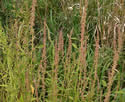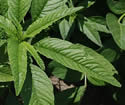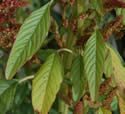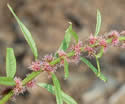Amaranthus tuberculatus (Rough-fruited Waterhemp)
| Also known as: | Rough-fruited Amaranth, Tall Water-hemp, Common Waterhemp, Tubercled Amaranth |
|---|---|
| Genus: | Amaranthus |
| Family: | Amaranthaceae (Amaranth) |
| Life cycle: | annual |
| Origin: | native |
| Status: |
|
| Habitat: | sun; dry to wet; shores, river banks, floodplain forest, farm fields, ditches, waste places, sedge meadows, swales |
| Bloom season: | July - October |
| Plant height: | 20 inches to 6+ feet |
| Wetland Indicator Status: | GP: FAC MW: OBL NCNE: OBL |
| MN county distribution (click map to enlarge): |  |
| National distribution (click map to enlarge): |  |
Pick an image for a larger view. See the glossary for icon descriptions.
Detailed Information
Flower: 

![[photo of flowering male plant]](/udata/r9ndp23q/pd/amaranthus-tuberculatus-4938509-6-t.jpg) Tiny flowers are tightly packed in small clusters (glomerules) in a spike-like arrangement at the tips of branching stems and arising from leaf axils, with a few to several flowers in a glomerule, and separate male and female flowers on separate plants (dioecious). Spikes are slender but variably arranged, from numerous short, dense branches to few branches that are 6+ inches long and more loosely arranged with distinct gaps between glomerules (interrupted).
Tiny flowers are tightly packed in small clusters (glomerules) in a spike-like arrangement at the tips of branching stems and arising from leaf axils, with a few to several flowers in a glomerule, and separate male and female flowers on separate plants (dioecious). Spikes are slender but variably arranged, from numerous short, dense branches to few branches that are 6+ inches long and more loosely arranged with distinct gaps between glomerules (interrupted).
![[close-up of male flowers]](/udata/r9ndp23q/pd/amaranthus-tuberculatus-072817-s1-t.jpg) Male flowers have 5 yellow stamens and 5 tepals that are 2 to 3 mm (to 1/8 inch) long, thin, translucent whitish with a green midrib, pointed to somewhat rounded at the tip. Female flowers have a 3 or 4-parted style at the tip of an oval green ovary and lack tepals or have only 1 or 2, the larger typically less than 2 mm long. At the base of each flower is a bract that is 1 to 2 mm long, shorter than the male tepals, green, pointed at the tip.
Male flowers have 5 yellow stamens and 5 tepals that are 2 to 3 mm (to 1/8 inch) long, thin, translucent whitish with a green midrib, pointed to somewhat rounded at the tip. Female flowers have a 3 or 4-parted style at the tip of an oval green ovary and lack tepals or have only 1 or 2, the larger typically less than 2 mm long. At the base of each flower is a bract that is 1 to 2 mm long, shorter than the male tepals, green, pointed at the tip.
Leaves and stems: 

![[photo of leaves]](/udata/r9ndp23q/green/amaranthus-tuberculatus-rough-fruited-amaranth_0905_102046-t.jpg) Leaves are alternate, ½ to 6 inches long, ¼ to 1¼ inches wide, widest at or below the middle, hairless, toothless, flat to somewhat wavy around the edges, mostly blunt at the tip, somewhat rounded to wedge-shaped at the base, on a hairless stalk usually not more than half as long as the blade. The lower leaves are largest, narrowly lance-elliptic to egg to diamond-shaped, becoming smaller and often more lance-linear to oblong-elliptic on the upper stem into the flower clusters. Stems are hairless and green to reddish. Plants are variable from erect to sprawling, few-branched to many-branched, spindly to robust.
Leaves are alternate, ½ to 6 inches long, ¼ to 1¼ inches wide, widest at or below the middle, hairless, toothless, flat to somewhat wavy around the edges, mostly blunt at the tip, somewhat rounded to wedge-shaped at the base, on a hairless stalk usually not more than half as long as the blade. The lower leaves are largest, narrowly lance-elliptic to egg to diamond-shaped, becoming smaller and often more lance-linear to oblong-elliptic on the upper stem into the flower clusters. Stems are hairless and green to reddish. Plants are variable from erect to sprawling, few-branched to many-branched, spindly to robust.
Fruit: 

![[photo of developing fruit]](/udata/r9ndp23q/green/amaranthus-tuberculatus-rough-fruited-amaranth_0904_120526-t.jpg) Spikes turn red to brown with maturity. Fruit is a dry seed enclosed in the persistent ovary shell (pericarp); the top of the pericarp may separate like a cap in a straight line around the middle, or irregularly, or not at all. Seeds are lens-shaped, .7 to 1.5 mm long, shiny, dark reddish-brown to dark brown.
Spikes turn red to brown with maturity. Fruit is a dry seed enclosed in the persistent ovary shell (pericarp); the top of the pericarp may separate like a cap in a straight line around the middle, or irregularly, or not at all. Seeds are lens-shaped, .7 to 1.5 mm long, shiny, dark reddish-brown to dark brown.
Notes:
Rough-fruited Waterhemp is most often found in wet or seasonally wet places, such as floodplains, shores and river banks, but also along railroads, roadsides and other waste places. It's considered native to the Midwest but has become a major, herbicide-resistant, agricultural weed, has spread globally primarily as a contaminant in grain shipments and, according to one report, said to significantly reduce crop yields: soybeans by as much as 63% and corn up to 74%. In Minnesota, much attention has been given to the invasive Palmer's Amaranth (Amaranthus palmeri), but A. tuberculatus exhibits essentially the same undesirable traits.
Rough-fruited Waterhemp is distinguished by its overall hairlessness; separate male and female plants (dioecious); leaves that are mostly lance-shaped on a stalk usually up to half as long as the blade, the uppermost leaves often much smaller and narrower; male flowers with 5 stamens and 5 tepals all near equal in size, 2 to 3 mm long, and green bracts shorter than the tepals; female flowers with green bracts and 1 or 2 tepals at most, often none; spikes turning red to brown with maturity; pericarp may or may not separate in a straight line around the middle. The spikes are more slender and leaves tend to be proportionately narrower than most other spike-bearing Amaranthus species.
Most similar is Palmer's Amaranth (A. palmeri), which is also hairless, dioecious, and has slender spikes, but its leaf stalks are typically as long as or longer than the blade, spikes tend to be longer (to 2 feet), floral bracts are as long as or longer than the tepals, and female flowers have 5 well-developed tepals. All of the other spike-bearing Amaranthus species known to be in Minnesota have male and female flowers on the same plant (monoecious), and floral bracts usually longer than the tepals. Some references note two varieties of A. tuberculatus: var. rudis (a.k.a. Amaranthus rudis), considered a more western species, has female flowers with 1 or 2 tepals and pericarps that split cleanly around the middle, and var. tuberculatus, considered more northern and Midwest, has no tepals on female flowers and fruit that does not split cleanly. These vars are not recognized in Minnesota.
Native Plant Nurseries, Restoration and Landscaping Services ↓
More photos
 Rough-fruited Amaranth plant
Rough-fruited Amaranth plant Rough-fruited Amaranth plant
Rough-fruited Amaranth plant spindly Rough-fruited Amaranth
spindly Rough-fruited Amaranth robust Rough-fruited Amaranth
robust Rough-fruited Amaranth Rough-fruited Amaranth plants
Rough-fruited Amaranth plants Rough-fruited Amaranth plants
Rough-fruited Amaranth plants Rough-fruited Amaranth with Hoary Alyssum
Rough-fruited Amaranth with Hoary Alyssum Rough-fruited Amaranth in a ditch by a corn field
Rough-fruited Amaranth in a ditch by a corn field Rough-fruited Amaranth emerging in a soybean field
Rough-fruited Amaranth emerging in a soybean field more leaves
more leaves spikes are slender, may be interrupted; upper leaves are narrow
spikes are slender, may be interrupted; upper leaves are narrow insect eggs
insect eggs
Photos by K. Chayka taken in McLeod and Ramsey counties. Photos by Peter M. Dziuk taken at various locations around Minnesota.
Comments
Have you seen this plant in Minnesota, or have any other comments about it?






